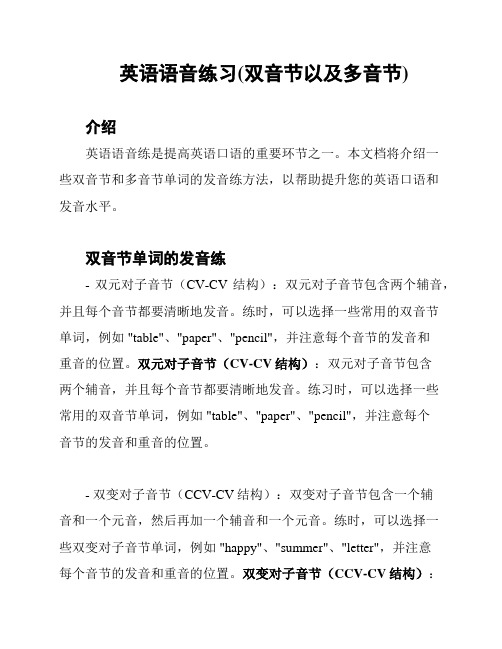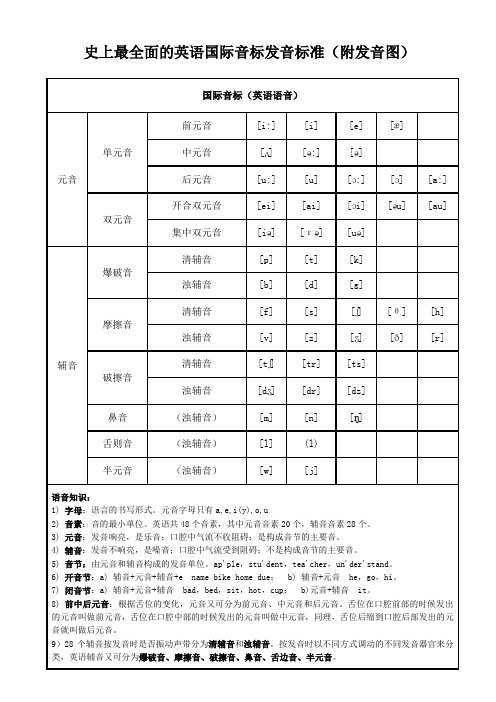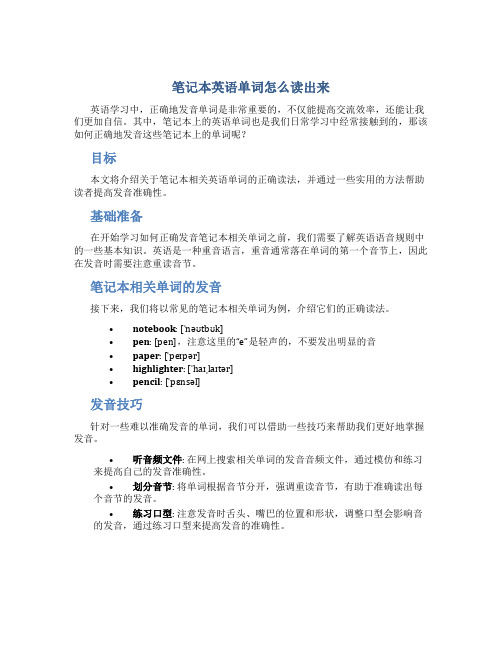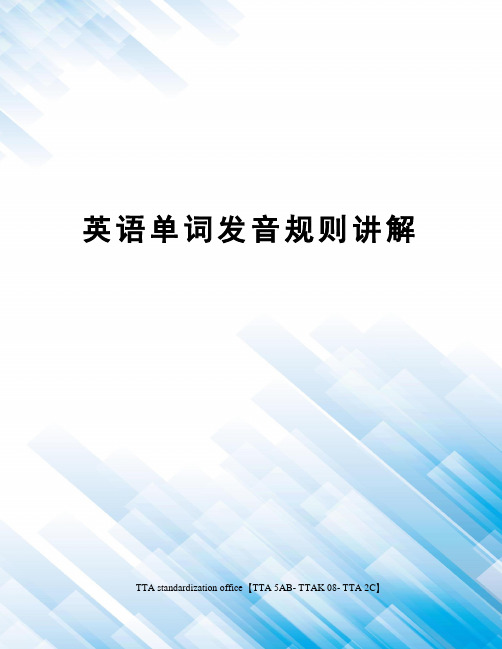Question Paper英语语音
英语语音练习(双音节以及多音节)

英语语音练习(双音节以及多音节)介绍英语语音练是提高英语口语的重要环节之一。
本文档将介绍一些双音节和多音节单词的发音练方法,以帮助提升您的英语口语和发音水平。
双音节单词的发音练- 双元对子音节(CV-CV结构):双元对子音节包含两个辅音,并且每个音节都要清晰地发音。
练时,可以选择一些常用的双音节单词,例如 "table"、"paper"、"pencil",并注意每个音节的发音和重音的位置。
双元对子音节(CV-CV结构):双元对子音节包含两个辅音,并且每个音节都要清晰地发音。
练习时,可以选择一些常用的双音节单词,例如 "table"、"paper"、"pencil",并注意每个音节的发音和重音的位置。
- 双变对子音节(CCV-CV结构):双变对子音节包含一个辅音和一个元音,然后再加一个辅音和一个元音。
练时,可以选择一些双变对子音节单词,例如 "happy"、"summer"、"letter",并注意每个音节的发音和重音的位置。
双变对子音节(CCV-CV结构):双变对子音节包含一个辅音和一个元音,然后再加一个辅音和一个元音。
练习时,可以选择一些双变对子音节单词,例如 "happy"、"summer"、"letter",并注意每个音节的发音和重音的位置。
- 变对双元音节(CV-CC结构):变对双元音节包含一个元音和一个辅音,以及一个辅音和一个元音。
练时,可以选择一些变对双元音节单词,例如 "paper"、"apple"、"bottle",并注意每个音节的发音和重音的位置。
变对双元音节(CV-CC结构):变对双元音节包含一个元音和一个辅音,以及一个辅音和一个元音。
英语读音规则总结

英语读音规则1.开音节1)以发音的元音字母结尾的单节。
例:be,he。
2)以辅音字母(r 除外)+不发音的e结尾的音节。
例:make,like。
* 在重读的开音节中元音字母按字母名称读音。
2.闭音节以一个或几个辅音字母(r 除外)结尾而中间只有一个元音字母的音节,称为闭音节。
例:map,desk,is。
* 在重读的闭音节中元音字母读做短元音。
一.字母a,e,i,o,u 在重读音节中的读法字母名称位置读音举例a /ei/ 开音节/ei/ name,take闭音节/æ/ map,bage/i:/ 开音节/i:/ be,he闭音节/e/ egg,besti /ai/ 开音节/ai/ like,kite闭音节/i/ bit,fito/əu/ 开音节/ou/ note,no闭音节/ɔ/ dog,lotu/ju:/ 开音节/ju:/ mute,use闭音节/ʌ/ bus,cut元音字母在重读音节中的特殊读音字母位置读音例子a 在[w]音后面/ɔ/ want wha t watch wash quality在f n sk ph sp ss st th前/α:/after plant graph ask grasp glass fast father I 在-nd -ld和gh前/ai/ find child light highO 在-st -ld前/əu/ most postcard old cold在m n v th前/ʌ/ come monkey love mother二、元音字母在非重读音节中的读音字母名称读音举例a /ei/ /ə/ China another woman breakfast/i/ orange comrade village cabbagee /i:/ /ə/ hundred student open weekend children/i/ chicken pocket begini /ai/ /ə/ holiday beautiful family animal/ai/ exercise satelliteo /əu/ /ə/ second tonight somebody welcome/əu/ also zero photou/ju:/ /ə / autumn difficult/ju:/ popular congratulation January动词中的a如果处在开音节位置,a读[ei]音,例如:operateu处在开音节位置,又在辅音字母j l r s后面时,读/u: /音,例如:July influence February issue三、-r音节元音字组在重读音节中的读音字母位置读音举例ar 在[w]音后面/α:/ car farm dark sharpener/ɔ:/ warm quarter towardsor/ɔ:/ forty morning short在[w]音后面/ə :/ word worker worseer ir ur /ə :/ certainly bird Thursday辅音字母r双写时,前面的元音字母不能与r构成-r音节,而是按重读闭音节的拼读规则,例如:carry sorry hurry-r音节在非重读音节中通常读[ə]音,例如:dollar teacher martyr forget Saturday四.-re音节元音字组在重读音节中的读音元音字组读音例句are/ɛə/ care dare hareere /iə/ here mereire /aiə / fire hire wireore /ɔ: / more score beforeure /juə/ pure cure完整的-re音节are ere ire ore很少出现在非重读音节中,ure在非重读音节中读[ʒə]音,例picture pleasure重读元音字母加r,再加非重读元字组时,重读元音字母应按-re音节拼读规则拼读,字母R 读[r]音。
史上最全面的英语国际音标发音标准(附发音图)

史上最全面的英语国际音标发音标准(附发音图)发音器官图及说明发音主要分为三部分:喉部、口腔、鼻腔。
A、喉部的发音器官:1.气管2.声带(包括声门)3.会厌软骨B、口腔的发音器官:4.舌:a.舌端 b.舌前部c.舌后部d.舌根5.硬腭6. 软腭7.上齿龈8.牙齿9.唇l0.小舌C、鼻腔26个英文字母音标表发音标准一、元音的发音Ⅰ单元音第一节前元音发音方法描述:发音时舌尖轻抵下齿,前舌部向上腭抬起,口形扁而平。
发音时间延续较长。
例词:Be meat sheep secret believe例句:I don’t believe it.He feels very weak.发音方法描述:发音时舌尖抵下齿,舌前部向硬腭抬起,口形扁平,发音时间短促。
例词:It big rich visit loaded business例句:It’s a very big city.I feel a bit dizzy.发音方法描述:舌尖抵下齿,前舌部向硬腭抬起,口形扁平,气流从口腔泄出,声带振动。
发音时间短促。
例词:Fed best them wedding refresh例句:Well fed,well bred.I will never forget petty. 发音方法描述:舌尖抵下齿,舌前部稍抬,双唇开口度较大,并向两边平展,发音短促。
例词:At have flat standsaturday例句:I’m glad to know that.He was born in a happy family.第二节后元音发音方法描述:舌身放低后缩,舌后部隆起,口形张大,全开,声带振动。
发音延续较长。
例词:Art fast March party advance例句:My father has a large farm.Please park your car in the car park.发音方法描述:舌身尽量降低并收缩,舌后部抬起。
英语音节划分重读规则读音规则

重音一、单词重音1.双音节词a 一般在第一个音节重读;letter, sorryb 有 a-, be-, de-, re-, res-, in-, im-, en-, em-, es-, ex-, con-, com-, dis-, mis-, pre-, per-, pro-, trans- 等前缀的词,第二个音节是重音;a'bout, be'lieve, ad'dress, de'cide, re'port, con'demn, res'pect, com'pare, in'form, dis'cuss, im'press, mis'take, en'force, pre'pare,em'ploy, per'mit, es'cape, pro'duce, ex'claim, trans'latec 有 de-, in-, re-, con-, pre-等前缀的重音与词义和词类有关, 一般名词的重音在第一个音节上,其它的词性在第二个音节上;'record, re'cord; 'insult, in'sult; 'conduct, con'duct; 'presentpre'sent; 'content, con'tentd 有些复合词和带有前缀 re-, ex-, un-, pre-, post-, 等的词,有两个重音;'out'side, 're'tell, 'well-'known, 'un'real, 'fif'teen, 'Chi'nese, 'pre-'war, 'post-'war2.多音节词a 一般倒数第三个音节是重音;'difficult, 'communist, 'family, e'conomy, oppor'tunity, de'mocracy.b 有一些双音节词,加了前缀和后缀成了多音节,但这些词按原来词根的重音读音;'carefully, in'definite, 'comfortable, con'ductor, ac'cording,dis'turbance, 'complicated,es'tablishment,c 词尾有-eous, -grahpy, -ial, -ian, -ic, -ics, -ience, ient, -ify, -ion, -ious, -ity, ive 后缀的词,重音在这些后缀的前一个音节上;cour'teous, cal'ligraphy, edi'torial, his'torian, peri'odic,mathe'matics, ex'perience,suf'ficient, i'dentify, trans'lation, re'ligious, curi'osity, pro'tectived 词尾有 -ain, -ee, -eer, -ese, -ette 后缀的词,重音在该后缀上,而且有一个次重音,次重音一般在主重音前第二个音节上;enter'tain, emplo'yee, mountai'neer, Japa'nese, ciga'rette, economical二、句子重音1.英语的节奏:轻-轻-重-轻-轻或重-轻-轻轻重2.英语句子的读音长短是由句子中的重读词的数目决定的,而不是象汉语那样由句子中的汉字数目决定的;3.实词重读副词重读,虚词轻读冠词,单音节介词,单音节连词,人称代词,反代词,物主代词,关系代词,相互代词,助动词,情态动词和系动词be4.实词不重读的特殊情况a 实词第二次出现 He thinks of that as a child thinks.b 一个名词被第二个名词修饰 I met her in the railway station.c 代替词 Which book do you want The small one.d感叹词中的 what 和how:What a good day it is How beautiful she ise this在这些短语中,this morning/afternoon/evening5.虚词重读的特殊情况a 情态动词,助动词和系动词be在句首,句尾和否定时;Do you like it Yes, I do.Are you a doctor Yes, I am.b 情态动词表示可能,惊奇和肯定时;They may come this evening.Can it be five alreadyc 介词在句首和句尾;In the box, he found a letter.He is the person I talked with.d 引导复合句的连词在句首;If you wish, I'll visit you. When he comes, I'll tell him.e 反身代词表示强调;He couldn't come himself.如何划分英语音节音节划分是拼读规则中的一个至关重要的内容,掌握它有利于拼读技能的落实;双音节单词的音节划分方法可归纳为“两分手”、“一归前或一归后”;1.“两分手”是指:当两个元音之间有两个辅音字母时,将两个辅音字母划分在前后两个音节里;具体细节以及读音特点,分别介绍如下:a. 当两个辅音字母相同包括字母 r ,且重读音节在词首时:better 划分成 bet tercarry 划分成 car ryyellow 划分成 yel lowborrow 划分成 bor rowlittle 划分成 lit tle第一个音节的元音按照短元音读,但是相邻的那一个辅音字母没有读音;注意:字母 l, r在非重读音节中,有时起元音的作用;如在单词little, acre 中;b. 带前缀的单词,有时也有两个相同的辅音字母包括字母 r ,如:attack划分成at tackarrive划分成 ar riveattend 划分成 at tendcorrect划分成 cor recteffect划分成 ef fectsupport划分成 sup port这样的单词,第一个音节是非重读音节,元音一般读含糊短元音;c. 当两个辅音字母不同不包括字母 r 时:sister 划分成 sis terwindow 划分成 win dowsystem 划分成 sys tem publish划分成 pub lish第一个音节的元音按照短元音读,相邻的辅音字母有读音;d. 当两个辅音字母不同,并且第一个辅音字母为 r 时:market 划分成 mar ketdirty 划分成 dir tycertain 划分成 cer tainsurface 划分成 sur face第一个音节的元音按照 r-音节读音;注意:不能够“两分手”的情况:a. 辅音字符th, sh, ch, tch, ck等,是不允许分割的;这样的单词有:fa ther, oth er, cash ier, ma chine, pock et, fash ionb. 各种辅音连缀,如 cr, pr, bl, fl, 等,也是不允许分割的;这样的单词有:April 只能划分成 A prilsecret 只能划分成 se cretapron只能划分成 a pronsacred 只能划分成 sa cred包括带前缀的一些单词,如 degree, decrease, across, agree, afraid 等;2.“一归前或一归后”是指:当两个元音之间只有一个辅音字母时,有时将这个辅音字母划分在前面的音节里,有时划分在后面的音节里;a. “一归后”的情况;如:open 划分成 o penable 划分成 a bleeven 划分成 e vennation 划分成 na tionfever 划分成 fe verunit 划分成 u nittiny 划分成 ti nystudent 划分成 stu dent显然,第一个音节的元音按照长元音读;带有以元音结尾的前缀的单词,自然是属于“一归后”的;如:begin 划分成 be ginrepeat 划分成 re peatdecide 划分成 de cidereturn 划分成 re turnprepare 划分成pre parerepair 划分成 re pair重读音节在第二个音节;b. “一归前”的情况;如:city 划分成 cit yminute 划分成 min utestudy 划分成 stud ysecond 划分成 sec ondtravel 划分成 trav elnever 划分成 nev er显然,第一个音节的元音按照短元音读;另外,字母 x 永远是划归第一个音节的;并且第一个音节读短元音;如:taxi划分成 tax i exit 划分成 ex it的常见方法英语单词是由字母组成的,而字母又构成音节,音节的核心是元音,由一个或几个元音字母代表;根据单词所含的音节,把单词分为单音节词、双音节词和多音节词;下面是几种划分音节的常见方法:1.如果两个音节之间只有一个辅音字母r除外,该字母要归后面的音节,第一音节要读作开音节;如:paper,student,open2.如果两音节之间有两个辅音字母第一个不是r,这两个辅音字母分别划归前后两个音节,第一个音节为闭音节;如:matter,window,happy,middle注:如果两个相同的辅音字母在一起并用时,只发一个辅音字母的音,如上例;3.如果两音节之间有两个辅音字母,第一个是r,这两个辅音字母可分别划归前后两个音节,第一个音节按r重读音节读,如:corner,certain如果分界线上的两个辅音字母都是r,前边的重读音节按闭音节读;如:carry,sorry,carrot,borrow4.辅音字母l,m,n等也可构成非重读音节,如:apple,bottle,noodle,often以上所讲正是:每个音节一元音,并连辅音两边分,还有一点需注音,字母组合不能分,缺少元音无音节,不算几个成节音;英语语音名词解释1.音节以元音为主体构成的发音单位,一般说来元音发音响亮,可以构成音节,辅音发音0-01不响亮,不能单独构成音节m n l例外;从单词拼写形式上看,有几个就有几个音节;2.音节的划分①在两个音节的相邻处有两个时,一个属于前面的音节,一个属于后面的音节;例如:le t-t er me m-b er chi l-dr en dau gh-t er②在两个音节的相邻处只有一个时,如果前面音节里的元音是则属于后面一个音节,如果前面一个音节里的元音是,则属于前面一个音节;例如: p a-per st u-dent f a-ther z e-ro m o-tor f ar-thers e v-en st u d-y m o th-er v e r-y m o d-le w ea th-er3.重读音节单词中读音特别响亮的音节;用音标标记双音节、多音节词的读音时,应使用重读符号;单音节词多数是重读音节,标记读音时不需要使用重读符号;0-03 4.开音节①绝对开音节:单个元音字母后面没有的重读音节;例如:n o bl u e b a-byst u-dent s e-cret.②相对开音节:单个元音字母后面加单个辅音字母,再加一个不发音字母e构成的重读音节;例如:n a m e th e s e b i k e h o m e ex-c u s e.0-045.闭音节单个元音字母后面有r w y 除外且以结尾的重读音节;例如:b a g e gg f i sh n o tc u p0-05 6.双音节词重读规则双音节词的第一个音节通常是重读音节;例如:´stu-dent ´Chi-na ´sec-ond ´au-tumn in-´deed含有a- be- de- re- in- ex-等前缀的双音节词往往是在第二个音节上重读;双音节词的重读位置不会因增加前缀或后缀而发生改变;例如:a´bout be´fore ex´cuse re´pair for-´get-ful in-´ven-tor0-067.多音节词重读规则多音节词通常在倒数第三个音节重读;例如:´el-e-phant con-grat-u-´la-tion词尾有-ic或-tion,-sion的词,在-ic或-sion,-tion前的一个音节上重读;例如:scien´tif ic im´pres sion ´na tion在中的读音读音例词编号a ei æe i:1-03 ei aii1-06oouuju:在中,u在j l r s后面时读u:音,例如:J u ne bl u e r u ler s u per1-11在非重读音节中的读音读音例词编号a Chin a a nother wom a n breakf a st2-01i or a nge comr a de vill a ge cabb a ge2-02ehundr e d stud e nt op e n week e nd2-03 i chick e n pock e t b e gin childr e n2-04i/i hol i day beaut i ful fam i ly an i mal2-05 ai exerc i se satell i te2-06osec o nd t o night someb o dy welc o me u als o zer o phot ouaut u mn diffc u lt2-09 ju:pop u lar congrat u lation Jan u ary2-10动词中的a如果处在开音节位置,a读ei音,例如:oper a te2-11u处在开音节位置,又在j l r s后面时,读u:音,例如:J u ly infl u ence Febr u aryiss u e2-12在非重读音节中,许多单词中的a e i 即可以读作音,也可以读作i音;在中的特殊读音读音例词编号a在w音后面a在f n sk ph sp ss st th前α:i在-nd -ld和gh前ai3-03 o在-st -ld前ouo在m n v th前-r音节在中的读音读音例词编号arar在w音后面α:4-01 :4-02oror在w音后面: :er ir ur:4-05辅音字母r双写时,前面的元音字母不能与r构成-r音节,而是按重读闭音节的拼读规则发音;例如:-r音节在非重读音节中通常读音,例如:4-07 -re音节在中的读音读音例词编号areε5-01 ere iire aiore :5-04 ure juare ere ire ore很少出现在非重读音节中,ure在非重读音节中读音,例如:重读加Rr,再加非重读时,重读应按-re音节拼读规则拼读,字母Rr读r音;例如:某些常用词及多音节词经常出现短化现象;例如:在中的读音读音例词编号ai/ay eiairε6-02alal在f m前sm al l b al l t al k w al l al l6-03 :l 6-04α:6-05au/aw:ea i:eei br ea k gr ea teari h ear d ear n ear cl ear y ear6-10εb ear p ear w ear sw ear6-11 :ear th l ear n ear ly6-12ee i:6-13 eer i6-14ei/ey ei6-15 i: k eyeu/ew在j l r s后ju:6-17 u:fl ew br ew j ew elry 6-18ie/eis音之后i:6-19 oa ouoar/oor:r oar b oar d d oor fl oor6-21 oi/oy i6-22oo u:6-23 u6-24ou/ow au6-25 ou kn ow r ow thr ow th ou gh6-27 u:gr ou p y ou s ou p6-28our:c our se y our f our6-29 au our h our our s6-30 :j our ney6-31ui在j l r s后ju:i fl ui d s ui cide t ui tion6-32 u:j ui ce fr ui t s ui t6-33非重读音节中和字母群的读音或读音例词编号ai/ay ei/ey i Sund ay for ei gn monk ey7-01 ow ou yell ow sparr ow tomorr ow7-02在非重读音节中读音或i;例如:neighb our seri ou s fam ou s bisc ui t coff ee7-03 -sion -tion n impres sion na tion7-04 -sion在元音字母后n vi sion deci sion occa sion7-05 -tion在s后n que s tion sugge s tion7-06 -sten sn li sten7-07-stle sl whi stle7-08-sure plea sure mea sure7-09-ture pic ture cul ture7-10在复合词非重读音节中的读音复合词中的第二部分不标注重音符号,但其中的或仍按重读音节拼读规则拼读;例如:everyd ay eihandb a gæblackb oar d:8-01有些词随着语言的发展,前后两部分已失去其单独存在的意义,融合成为一个词;其中的非重读部分要按非重读音节的读音规则发音;例如:sun太阳 + d ay ei日子> Sund ay i 星期天holy神圣 + d ay ei日子> holid ay i 假日break中断 + f a stα:斋戒> breakf a st早餐cup茶杯 + b oar d木板: > cupb oar d碗柜的读音读音例词编号b b b ike b us b ag9-01 /9-02cc在e前或在i/y前k c ake pi c ture c oat musi c9-03s fa c e de c ide c inema9-04chmu ch ch ick ri ch tea ch er9-05 k s ch ool heada ch e ch emistry9-06 ma ch ine Ch icago9-07-ck k co ck po ck et bla ck kno ck9-08 d d d octor brea d han d d ay 9-09 -dge bri dge fri dge9-10 dr-dr chil dr en dr iver dr ink9-11 f f f ive f our break f ast9-12gg在e i/y前ba g g ardon g ooran g e lar g e G ermangh f cou gh enou gh9-15 /li gh t dau gh ter hi gh9-16gu- -guegu在非重读音节中gu ess lea gue dialo gue9-17 w lan gu age an gu ish 9-18h h h ot h ead h ouse h and9-19 /9-20j j eep j ar j oke j oin J uly9-21 k k k ind bi k e s k ate ma k e wee k9-22 kn-n k nife k now k nock9-23 l l l ife mi l k schoo l tal l9-24 m m m onkey co m e autu m n9-25 -mn m autu mn colu mn sole mn9-26nn在k g音前n n ot shi n e te n n ote 9-27 u n cle tha n k hu n gry9-28-ng morni ng you ng wro ng9-29 p p p a p er p lane p ig shi p p en9-30 ph f ele ph ant ph oto tele ph one9-31 q k Ira q9-32 qu-kw qu ality qu ite 9-33 r r r ed r ubber r uler9-34s在词首或清辅音前元音字母间或浊辅音前s s it s leep de s k9-35 z mu s ic hu s band9-36sc-sk sc arlet9-37 s mu sc le sc ience9-38sh sh e fi sh sh irt wa sh9-39 t在通常情况下在弱读字母ia ie t t en le t ter mee t9-40io前pa t ient na t ion9-41 tch wa tch9-42th在通常情况下在冠词代词介词连词中在词尾-the -ther中θth in th irty me th od9-43 th e th ese wi th th an9-44clo th e fa th er wea th er9-45tr-tr tr ee tr ain coun tr y tr uck9-46 v v v ery v oice lo v e lea v e9-47w w w eek w in w ake s w eet w ait9-48 /ans w er t w o 9-49wh-wh-在字母o前w wh at wh en wh ite wh y9-50 h wh o wh ose wh ole9-51x在重读元音前ks bo x te x t e x ercise9-52 gz e x amle e x ist e x act9-53wr-r wr ite9-54 y-j y es y ard y ellow y oung9-55 z z puz z le z ero z oo。
英语读音知识

英语发音规则一、英语音素音素是最小的语言发音单位;英语音素共48个,其中元音音素20个,辅音音素28个;二、英文字母英文字母是英语最小拼写单位,共26个,其中元音字母5个,辅音字母21个;除了5个元音字母外,辅音字母发音与音素表不对应也不相同;三、英文字组和字群“英语字组”是指一个或几个字母在起,发一个音素,是拼读英语单词的基本单位,一个英语字组对应一个音素;字组分为元字组元音字母和元音字母组合和辅字组辅音字母和辅音字母组合;英语字组共73个,元字组包括元音字母5个,元音字组28个,辅字组包括辅音字母21个,辅音字组19个;字组共73个,其中字母26个,字母组合47个;字群是指几个字组在同一个音节里发两个以上的音素,常见字群共6个;三、英语单词发音规则1、单词发音构成:单词由一个或多个音节组成,同一单词音节分为重读音节和非重读音节;在一个词中,有几个元音音素不是元音字母,就有几个音节;只有一个元音音素的单音节词;有两个元音音素的叫双音节词,有三个或三个以上元音音素的叫多音节词;2、音节:以元音为主体构成的发音单位,一般说来元音发音响亮,可以构成音节,辅音发音不响亮,不能单独构成音节m n ŋ l例外;从单词拼写形式上看,有几个元字组就有几个音节;出现在词尾且不发音的 e 不能构成音节;3、音节构成:音节是词的构成单位;就语音形式而言,一个音节通常由一个元音音素加上一个或几个辅音音素构成;就书写形式而言,一个音节一般由一个元音字母或元音字母组合加上一个或几个辅音字母构成;单独一个元音或元音字母也可以构成一个音节;4、音节类别:1开音节包括绝对开音节和相对开音节;①绝对开音节:单个元音字母后面没有辅字组的重读音节;例如:no blue ba-by stu-dent se-cret.②相对开音节:单个元音字母后面加单个辅音字母,再加一个不发音字母e构成的重读音节;例如:name these bike home ex-cuse.2闭音节:单个元音字母后面有辅字组r w y 除外且以辅字组结尾的重读音节;例如:bag egg fish not cup3成音节:m、n、l、ŋ 是发音较为响亮的辅音,与别的辅音结合成不含元音的音节;例:ap-ple doub-le elev-en rhyth-m sev-en ta-ble troub-le5、音节划分:1在重读和非重读音节的相邻处有两个辅字组时,一个辅字组属于前面的音节,一个属于后面的音节,一般辅音字组不可被拆分;例如:let-ter mem-ber chil-dren daugh-ter mas-ter prac-tice doc-tor;有时辅音字母连缀bl cl- fl- gl- pl- br- cr- fr- gr- pr-被看作一个整体,划分音节时可以不被分开,如:se-cret Ne-gro fra-grant ze-bra 以上例词中,字母连缀前的一个音节里的元字组发长音;如果字母连缀前的一个音节里的元字组发短音,字母连缀又会被分开;2在重读和非重读音节的相邻处只有一个辅字组时,如果前面重读音节里的元音是长音长元音和双元音则辅字组属于后面一个音节,如果重读音节里的元音是短音短元音,则辅字组属于重读音节;例如:长音pa-per fa-ther ze-ro mo-tor Si-mon stu-dent fea-ture e-ven短音cap-ital m oth-er ver-y mod-el Lil-y stud-y feath-er sev-en3划分音节时要考虑词的来源,如:baker 词源为bake,为保持词源的完整,音节划分为bak-erteacher 词源为teach,为保持词源的完整,音节划分为teach-er4非重读音节与非重读音节之间只有一个辅字组时,通常要使辅音处于音节开头的位置,就象汉字的读音一样,辅音开头,元音结尾;6、单词重读音节:重读音节是单词中读音特别响亮的音节,重读符号为“’”,标注在重读音节前左上方;次重读符号“’”,标注在重读音节前左下方;在双音节词和多音节词中,必有一个音节读得较其他音节重而强,这个音节称为重读音节;其余的音节读得轻而弱,称为非重读音节;有的多音节词可能有两个重音,其中一个是主要重音,另一个是次重音,或两个都是主要重音;1单音节词:单音节词多数是重读音节,标记读音时不需要使用重读符号;2双音节词:双音节词通常第一个音节重读;3多音节词:多音节词通常在倒数第三个音节上重读;在多音节单词中有时还要使用次重读,用来说明其中的元字组要按重读音节中的读音规则发音;①含有a- be- com- con- de- dis- em- en- es- ex- for- im- in- mis- per- pre- pro- re- trans- 等前缀的词通常在第二个音节上重读;加前缀或后缀通常不会改变原词的重音位置;②含有元音重出的词:有一些词的拼写中有ia ie io 等两个元音字母连在一起,这叫做元音重出;元音重出虽然有时只发一个元音,但在计算音节数目的时候算两个音节;③含有de- in- re- con- pre- 等前缀的词也可以在第一个音节上重读,往往因为主重读位置不同而词的意义和词类也不同;④以-ic 结尾的词在-ic 前的一个音节上重读;四、英语句子读音规则1、连读1定义:在连贯地说话或朗读时,在同一个意群即短语或从句中,如果相邻的两个词前者以辅音音素结尾,后者以元音音素开头,就要自然地将辅音和元音相拼,构成一个音节,这就是连读;连读时的音节一般不重读,只需顺其自然地一带而过,不可以加音,也不可以读得太重;如:notatall这个短语;连读时听起来就像是一个单词;连读只发生在句子中的同一个意群中;在两个意群之间即使有两个相邻的辅音和元音出现,也不可连读;如:Pleasetakealookatit.这个句子中takealookatit是同一个意群,那么take与a可连读,look与at可连读,at与it可连读;在Thereisabookinit.一句中book与in往往不连读,因为book与in分别在两个不同的意群中;2类型:①“辅音+元音”型连读:在同一个意群里,如果相邻两词中的前一个词是以辅音结尾,后一个词是以元音开头,这就要将辅音与元音拼起来连读;I’m~an~English boy. It~is~an~old book. Let me have~a look~at~it.Ms Black worked in~an~office last~yesterday. I called~you half~an~hour~ago. Put~it~on, please. Not~at~all.Please pick~it~up.②“r/re+元音”型连读:如果前一个词是以-r或者-re结尾,后一个词是以元音开头,这时的r或re不但要发r,而且还要与后面的元音拼起来连读; They’re myfather~and mother. I looked for~it here~and there. There~is a football under~it. There~are some books on the desk. Here~is a letter for you. Here~are four~eggs. But where~is my cupWhere~are your brother~and sister但是,如果一个音节的前后都有字母r,即使后面的词以元音开头,也不能连读; The black clouds are coming nearer and nearer.nearer与and不可连读③“辅音+半元音”型连读音的同化:英语语音中的j和w是半元音,如果前一个词是以辅音结尾,后一个词是以半元音,特别是j开头,此时也要连读; Thank~you. Nice to meet~you. Did~you get there late~again Would~you like~a cup~of tea Could~you help me, please “音的同化”—常把d+j读成dV,did you听上成了dIdVu,would you成了wudVu,could you成了kudVu;④“元音+元音”型连读:如果前一个词以元音结尾,后一个词以元音开头,这两个音往往也要自然而不间断地连读到一起; I~am Chinese.He~is very friendly to me.She wants to study~English. How~and why did you come here She can’t carry~it.It’ll take you three~hours to walk there. The question is too~easy for him to answer.⑤当短语或从句之间按意群进行停顿时,意群与意群之间即使有两个相邻的辅音与元音出现,也不可连读;Is~it a~hat or a cat hat与or之间不可以连读There~is~a good book in my desk. book与in之间不可以连读Can you speak~English or French English与or之间不可以连读Shall we meet at~eight or ten tomorrow morning meet与at,eight与or之间不可以连读She opened the door and walked~in. door与and之间不可以连读2、弱读1概念:实词重读,如动词、名词、副词等;虚词弱读,如介词、代词等;一个单词在强读或弱读具有不同两种或两种以上发音时,这些不同的形式就叫词的强读式或弱读式;把握不好单词的弱读式,尤其是非重词的弱读式,就会导致说话不流畅,从而失去英语特有的节奏感;2弱读单词:英语单词中有强读式和弱读式的单词大约有50多个,而且他们多出现在句子的非重读音节里;从词性上看,它们大多为单音节的限定词、助动词、动词be、介词、关联词和人称代词等;3弱读规律①弱读式只出现在句子的非重读的弱读词中;②单词单独出现时,无论采用实词还是虚词都采用强读式;③出现在句首或句末的单词,无论是实词还是虚词都采用强读式;④在句中被特别强调的实词或虚词,采用强读式;⑤虚词的强读式和弱读式:一般情况下,虚词在句子中不重读,常以弱读形式出现在语流中;因而,虚词一般有一个或一个以上的弱读形式;虚词弱读的读音变化规律:一是长音弱读变短;二是元音前面的辅音被省略;三是辅音前面的元音被省略;四是元音一般弱读为ə音;五是部分虚词有多种弱读形式;3、失音1概念:由于失去爆破是失音的一种现象,摩擦音也会被失去,所以统称为失音;注意:爆破音并不是完全失去,仍然形成阻碍,把气流堵在里面,但不爆破,直接发出相邻的辅音;失去爆破6个爆破音有3对p和b、t和d、k和g;失去爆破,又叫不完全爆破,就是在某些情况下,只须做出发音的准备,但并不发音,稍稍停顿后就发后面的音;2类型:①“爆破音+爆破音”型:6个爆破音t、d、k、g、p、b中的任意2个相临时,前一个爆破音会失去爆破,即由相关的发音器官做好这个发音的姿势,稍做停顿后即发后面的爆破音; The girl in the red coat was on a black bike just now. The big bus from the fac tory is full of people.What time does he get up every morning This is an old picture of a big car. The old doctor has a cat, too.We’re going to work on a farm next Tuesday. What would you like, hot tea or blackcoffee It’s a very cold day, but it’s a good day. You can put it down in the big garden.I bought a cheap book, but it’s a good book.②“爆破音+摩擦音”型:如果前面是爆破音,其后紧跟着某些摩擦音如f,s,W,T等,那么前面那个爆破音仅有十分轻微的爆破,而后面那个摩擦音则要完全爆破; Good morning, Mr. Bell. Good morning, dear.Uncle Li’s factory is quite near to the cinema. I went there alone at nine last night.-Do you know his bike number -Sorry, I don’t know. The forty-first lesson is quite difficult. Good luck, Lin Tao.③爆破音+m/n,爆破音也会失爆;美语中n后面的t不发音;4、浊化1S 后面的清辅音k,t,p要浊化g,d,b Discussion:k 浊化成g Stand:t 浊化成d Expression:p浊化成b;2美音中:t 在单词的中间被浊化成d 如:writer, 听起来和rider 的发音几乎没有区别letter—ladder out of 美国人和加拿大人发音为了省事,习惯清音浊化,尤其是t在单词的中间一定会浊化成d, 但英国人发音不会这样,这也是英音和美音的一大区别; 了解这一浊化原则,会给听力带来一些帮助;五、英语句子的升降调1、陈述句读降调:He works hard every day.2、一般疑问句读升调:Are you a doctor Do you speak English3、特殊疑问句读降调:Who are you4、选择疑问句前升后降:Do you speak English or French5、反义疑问句前降后升,但把握较大时前后都降:You know it,don't youIt is fine,isn't it6、感叹句读降调:How clever she is7、祈使句表示命令读降调,表示请求用升调:Don't moveSit down,please.8、陈述疑问句用升调:You are a policeman9、未听清对方的话,要求对方重复一下用升调:What Who When For what Pardon10、句子较长,中间划分意群停顿时通常都读升调;。
笔记本英语单词怎么读出来

笔记本英语单词怎么读出来英语学习中,正确地发音单词是非常重要的,不仅能提高交流效率,还能让我们更加自信。
其中,笔记本上的英语单词也是我们日常学习中经常接触到的,那该如何正确地发音这些笔记本上的单词呢?目标本文将介绍关于笔记本相关英语单词的正确读法,并通过一些实用的方法帮助读者提高发音准确性。
基础准备在开始学习如何正确发音笔记本相关单词之前,我们需要了解英语语音规则中的一些基本知识。
英语是一种重音语言,重音通常落在单词的第一个音节上,因此在发音时需要注意重读音节。
笔记本相关单词的发音接下来,我们将以常见的笔记本相关单词为例,介绍它们的正确读法。
•notebook: [ˈnəʊtbʊk]•pen: [pen],注意这里的“e”是轻声的,不要发出明显的音•paper: [ˈpeɪpər]•highlighter: [ˈhaɪˌlaɪtər]•pencil: [ˈpɛnsəl]发音技巧针对一些难以准确发音的单词,我们可以借助一些技巧来帮助我们更好地掌握发音。
•听音频文件: 在网上搜索相关单词的发音音频文件,通过模仿和练习来提高自己的发音准确性。
•划分音节: 将单词根据音节分开,强调重读音节,有助于准确读出每个音节的发音。
•练习口型: 注意发音时舌头、嘴巴的位置和形状,调整口型会影响音的发音,通过练习口型来提高发音的准确性。
结语在英语学习中,正确的发音是很重要的一环,特别是对于一些常见的单词,比如笔记本上的单词,掌握它们的正确发音将有助于我们提高交流能力。
希望本文所介绍的关于如何发音笔记本相关单词的方法能帮助到读者,让大家在学习英语的道路上更加得心应手。
以上就是关于如何读出笔记本英语单词的全部内容,希。
英语单词发音规则讲解

英语单词发音规则讲解 TTA standardization office【TTA 5AB- TTAK 08- TTA 2C】英语单词发音规则表一、在中的读音读音例词编号a [ei] []e [i:] 1-03 [e]i [ai][i] 1-06o [ou] []u [ju:] []在中,u在j l r s后面时读[u:]音,例如:1-11 二、在非重读音节中的读音读音例词编号a [][i] or a nge comr a de vill a ge cabb a ge 2-02e [] hundr e d stud e nt op e n week e nd [i] chick e n pock e t b e gin childr e ni []/[i] hol i day beaut i ful fam i ly an i mal 2-05 [ai] 2-06o [] [u]u[] aut u mn diffc u lt 2-09 [ju(:)] 2-10动词中的a如果处在开音节位置,a读[ei]音,例如:u处在开音节位置,又在j l r s后面时,读[u(:)]音,例如:J u ly infl u enceFebr u ary iss u e2-12 在非重读音节中,许多单词中的a e i 即可以读作[]音,也可以读作[i]音。
三、在中的特殊读音读音例词编号a在[w]音后面[]a在f n sk ph sp ss st th前[α:]i在-nd -ld和gh前[ai] 3-03 o在-st -ld前[ou]o在m n v th前[]四、-r音节在中的读音读音例词编号arar在[w]音后面[α:] 4-01 [:] 4-02oror在[w]音后面[:] [:]er ir ur [:] 4-05 辅音字母r双写时,前面的元音字母不能与r构成-r音节,而是按重读闭音节的拼读规则发音。
例如:-r音节在非重读音节中通常读[]音,例如:4-07 五、-re音节在中的读音读音例词编号are [ε]ere [i]ire [ai]ore [:] 5-04 ure [ju]完整的-re音节are ere ire ore很少出现在非重读音节中,ure在非重读音节中读[]音,例如:非重读音节中-re音节的变体通常发[r]音,例如:salary重读加Rr,再加非重读时,重读应按-re音节拼读规则拼读,字母Rr读[r]音。
英语语音语调特征及常见问题对比分析

英语语音语调特征及常见问题对比分析作者:王海华来源:《新教育时代》2015年第17期摘要:本文从语音语调的角度,对英语中的清浊辅音、长短元音、轻重音节差异进行了分析,并对语调、重音和节奏做了对比分析,从而提出在进行口语教学的过程中,要重视这种差异,进行对比教学,提高初学者的语言差异化意识。
关键词:语音 ; 语调 ; 对比前言:众所周知,在学习一种外语的语音系统时,都要受到本族语发音习惯的干扰。
所以,教学材料中语音练习资料的编写必须以语音理论为指导,然后进行大量的实践。
同时,教学材料也可以利用学生己经掌握的母语知识,对英汉两个语音系统的有关方面,适当地进行对比分析,找出两者之间的异同,然后针对中国学生在英语发音上的独特困难,设计专门的练习和指导。
比如,以下这些语音语调问题就是教材编制者及教学人员应该特别考虑的(吕叔湘,1980):一、语音1.清浊辅音中国学生容易出现两个问题。
首先,把浊辅音发成清辅音。
例如,把b念成p,把d念成t。
其次,词末辅音容易出错。
其表现方式就是把词末的b、p、d等音拖长,人为地加了个模糊元音。
这是因为汉语普通话里没有用这种辅音收尾的字,学生在发音时也没有用它收尾的习惯。
2.长短元音英语里的长音不仅是指[a:)[i:][u:]等单元音,也包括[ai][au][ei]等复合元音。
中国学生在元音发音上的问题主要是长音不够长,短音不够短。
这是因为汉语的韵母发音的时间长短都差不多,只是四声略有差别。
中国学生把这个习惯带到了英语中去,就容易把长音和短音发得长短差不多。
英语里长音和短音的分别很重要,有些单词的分别就在元音长短上。
例如,seat和sit。
3.轻重音节英语中的单词,不管有几个音节,只有一个重读的音节,如果是多音节词,里边有一个次重音。
所以,遇到多音节词,必须首先弄清楚重音落在哪个音节上。
轻读音节里的元音,如果是长音,只是读得轻些,还是保持原来的音质不变,如unite的第一个音节,quality的最后一个音节,expiration的第二个音节。
- 1、下载文档前请自行甄别文档内容的完整性,平台不提供额外的编辑、内容补充、找答案等附加服务。
- 2、"仅部分预览"的文档,不可在线预览部分如存在完整性等问题,可反馈申请退款(可完整预览的文档不适用该条件!)。
- 3、如文档侵犯您的权益,请联系客服反馈,我们会尽快为您处理(人工客服工作时间:9:00-18:30)。
Question PaperTESTI. Which did you hear? (1 mark for each correct answer)Choose from the following groups of words the one you hear. Mark the corresponding letter in your Answer sheet. Each of the words will be read once only.A B C D1. feel fell fill fail2. heal hill hell hail3. lead lid led laid4. keen kin ken cane5. part pot port put6. card cod cord code7. Mark Mack muck mock8. dark dock duck dirk9. each itch etch H10. heart hut hurt hot11. lark luck lurk lock12. short shut shirt shot13. veil fail whale rail14. low law no nor15. neat knit leet lit16. toil toll tall toe17. caught curt coat cot18. walk work woke wok19. light night right white20. born barn burn bun21. rare rear weir where22. chair cheer share sheer23. blaze plays braise praise24. blows plows browse prows25. blight plight bright pride26. glaze clays graze craze27. glean clean green cream28. glue clue grew crew29. crutch crush crash crass30. sheep ship cheap chipII. Choose the correct answers/responses to the statements/questions you hear. Mark the corresponding letter in your Answer sheet. Each of the sentences will be read once only. (1.5 marks for each correct answer)1.The woman is planning to ________.A. go awayB. stay for sometime2.What did they hear?A. The cattle.B. The kettle.3.The speaker was talking about the ________.A. bendB. band4.What has been stolen?A. The cock.B. The cork.5.Where are the girls going to?A. The show.B. The shore.6.The speaker was talking about the ________.A. debtB. date7.What did she get?A. CheersB. Chairs.8.The speaker was talking about the ________.A. bearB. beer9.The speaker must have got a lot of ________.A. shocksB. socks10.10. The speaker was talking about cleaning the ________.A. dishesB. ditches11.What is the old man doing?A. Joking.B. Choking.12.The speaker was talking about the ________.A. trainsB. drains13.The speaker was talking about the ________.A. girlB. curl14.What did he dial?A. A long number.B. A wrong number.15.What is the examiner doing?A. Collecting papers.B. Correcting papers.16.Did the speaker hear any sounds in the background?A. No.B. Yes.17. What are they doing?A. Collecting the television.B. Connecting the television.18.What does the USA have?A. Vast motorways.B. Fast motorways.19. What is the speaker looking for?A. Veils.B. Whales.20. The speaker was asking about the ________.A. thumbB. sumIII. Listening comprehension (2 marks for each correct answer)You are going to hear 20 sentences or phrases. Each of the sentences or phrases will be said twice. Decide which of the sentences or phrases in your question paper is closest in meaning to the one you hear from the tape. Mark the corresponding letter in your Answer sheet.1.A. The speaker is saying that they've bought a new car.B. The speaker is asking whether they've bought a new car.C. The speaker is asking what type of car they've bought.2.A. I know John, who is Bill's son, and I know Harry.B. I know Bill's son, I know John, and I know Harry.C. I know Bill, I know John, and I know Harry.3.A. He was one of the people who translated the book.B. He not only wrote the book but also translated it.C. He not only translated the magazines but also the book.4.A. The speaker is commanding someone to shut the window.B. The speaker is politely asking someone to shut the window.C. The speaker is asking someone's opinion about shutting the window.5.A. She dressed herself and fed the baby.B. She dressed the baby and fed the baby.C. She not only dressed the baby but also fed the baby.6.A. I know one particular sheep that can swim.B. I know that all sheep can swim.C. I know that some sheep can swim.7.A. The speaker is remarking on how great John's enjoyment was.B. The speaker is asking if John enjoyed it.C. The speaker is saying that John did not enjoy it.8.A. If you hit him on the head he will not be able to do it.B. Even if you hit him on the head he would still refuse to do it.C. You have to hit him on the head to make him do it.9.A. He can see, but not very clearly.B. It is clear that he can't see at all.C. The day is so clear that he can't see anything.10.A. I thought she was married, but she isn't.B. I thought she was married, and so she is.C. I thought about her marriage.11.A. I went out, but not because I wanted to see you.B. I stayed home, because I wanted to see you.C. I stayed home, but I couldn't see you.12.A. The speaker is asking a question in a rude way.B. The speaker is asking a question in a neutral way.C. The speaker is asking a question in a polite way.13.A. I have no doubts about his competence, but I doubt his motivations.B. I have no doubts about his competence or about him at all.C. I don't think he's very competent.14.A. She drinks coffee, but only special types.B. She drinks no coffee at all.C. She prefers tea to coffee.15.A. The children have left.B. Someone has left the children.C. The children have left someone.16.A. The speaker is offering tea, or coffee, or something else.B. The speaker is offering either tea or coffee only.C. The speaker wants to offer coffee instead of tea.17.A. She gave dog biscuits to somebody.B. She gave biscuits to her dog.C. She gave dog biscuits to her dog.18.A. He should have told me, but he didn't.B. It is possible that he has told me, but I forgot.C. He should have told me, and so he has.19.A. Some children were playing and only they looked unhappy.B. All the children were playing and all looked unhappy.C. The children were playing because they looked unhappy.20.A. I'm sure I've seen you here before.B. You may have been here before, but I'm not sure about it.C. I'm disappointed that you've been here before.IV. Choose the words you hear in the parentheses in the following sentences. (1 mark for each correct answer)V. Listening for informationListen to the following conversations between a doctor and a patient in a hospital emergency department. Write the information in the appropriate box in the table. Conversation 1 serves as an example. You will hear each of the conversations twice.(2.5 marks for correct answers for each of the conversations)VI. Listen to the following talk and fill in the missing words. You will hear the talk twice. (2 marks for each correct phrase.)VII. Write the phrases or sentences you hear from the tape. Each of the phrases/sentences will be read twice. (2 marks for each correct sentence)。
